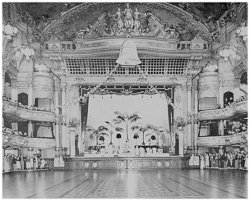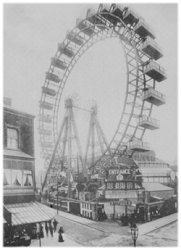
Blackpool Tower under construction in 1893
Blackpool Tower

Blackpool Tower under construction in
1893
The last decade of Queen Victoria's reign saw the most dramatic perils of expansion in Blackpool's history. The focus of the resort's attractions was Central Beach, where since 1874 had stood Dr. Cocker's Aquarium and Menagerie. In 1891, work began on a 520-foot tower, named the Blackpool Eiffel Tower. It was to be a half-size version of the Paris tower completed two years earlier. The tower was to be the centrepiece of a great new entertainment centre, with an aquarium, menagerie, aviary, bear pits, Old English Village, ballroom, Tower ascents and roof gardens. The Tower was opened in 1894, and the foreign "Eiffel" was dropped from its title.
On Queen Victoria's Diamond Jubilee Day, 22nd June 1897, the Tower stayed opened until 1.00 a.m., to allow people to see the bonfires which were lit all over the countryside. Exactly a month later, the process was reversed as the people stood in the streets to watch the Tower itself on fire. Fortunately the Tower top was deserted at the time, but staff attempting to put out the fire were driven back by the flames. The fire was left to burn itself out, with only slight damage, a tribute to the success of the architects in fireproofing the building.

The Tower Ballroom
The new tower buildings were a serious challenge to the Winter Gardens, opened in 1878, where complete under-cover entertainment was already established. To compete with the Tower's vertical attractions, the Winter Gardens management decided to build a wheel 240 ft. high on land alongside their entrance in Coronation Street. The Big Wheel was completed in 1896, and had 30 carriages, each with room for 30 passengers. At first, crowds flocked to ride on the wheel, which had a speed of 1/2 m.p.h., but when the novelty wore off it proved to be a disastrous mistake. It was demolished in 1928.

The Big Wheel in 1896
On 2nd October 1926, the Earl of Derby officially opened the Marine Parade and Stanley Park. Colonnades, sunken gardens, rock gardens, a waterway and cliff rockery were features of the Promenade. It was an extension of that completed in 1905.